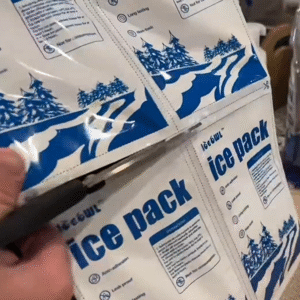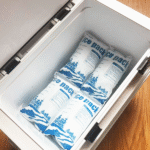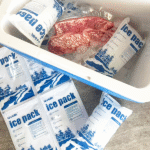Rapid Freeze Dry Ice Pack: How It Helps in Cold Chain Logistics
In cold chain logistics, preserving the integrity of temperature-sensitive shipments is crucial. Rapid freeze dry ice packs are emerging as the go-to solution for efficient, cost-effective, and safe temperature control. They are particularly beneficial for industries like pharmaceuticals, biotech, and perishable food shipping, where maintaining strict temperature conditions is vital throughout transit. This guide explores the advantages of rapid freeze dry ice packs and how they are transforming cold chain logistics in 2025.

What Are Rapid Freeze Dry Ice Packs?
Rapid freeze dry ice packs are solid carbon dioxide (CO₂) products that sublimate directly from solid to gas at −78.5°C (−109.3°F). Unlike traditional ice that melts and leaves water residue, dry ice sublimates into gas, ensuring that no liquid residue can damage products during transit. These packs are essential for shipments requiring sub-zero temperatures over extended periods, especially for temperature-sensitive goods like vaccines, biologics, and frozen foods.
How Do Rapid Freeze Dry Ice Packs Work?
The process behind rapid freeze dry ice packs is based on the sublimation of dry ice. When packed properly, these packs absorb heat from their surroundings as they sublimate, maintaining an ultra-cold environment. Dry ice is highly efficient because it provides a steady cooling temperature without turning into liquid. It is often used in containers with ventilation, allowing the CO₂ gas to escape and preventing pressure buildup.
Comparison of Cooling Methods
| Feature | Dry Ice Packs | Traditional Ice Packs |
|---|---|---|
| Temperature Range | −78.5°C (−109.3°F) | 0°C to 4°C |
| Cooling Duration | 24–72 hours | 6–12 hours |
| Residue | None (sublimates to gas) | Water (melts) |
| Reusability | Single-use | Reusable |
| Best Use Cases | Pharmaceuticals, Biotech, Frozen Foods | Chilled Foods, Beverages, Less Sensitive Goods |
Why Choose Rapid Freeze Dry Ice Packs Over Other Options?
For industries shipping temperature-sensitive goods, rapid freeze dry ice packs offer several advantages:
-
Extended Cooling Duration: They maintain cold temperatures for longer periods, often up to 72 hours, reducing the need for frequent replacements.
-
Environmental Safety: Dry ice sublimates into gas, leaving no liquid residue that could damage the packaging or product.
-
Cost Efficiency: Less dry ice is required for the same cooling effect compared to traditional ice packs, making it more cost-effective for long-duration shipments.
Are Rapid Freeze Dry Ice Packs Safe for Shipping?
Yes, rapid freeze dry ice packs are safe for shipping when handled properly. However, there are strict safety protocols, including ensuring adequate ventilation to allow CO₂ gas to escape. Sealed containers without venting can cause dangerous pressure buildup, leading to potential risks.
Safety Tips
-
Always use properly vented containers or boxes specifically designed for dry ice shipments.
-
Follow the Department of Transportation (DOT) regulations regarding labeling and safety during shipment.
-
Wear insulated gloves and goggles when handling dry ice to prevent frostbite and other injuries.
How Long Do Rapid Freeze Dry Ice Packs Last?
The longevity of dry ice packs depends on various factors such as the quantity used, packaging insulation, and the ambient temperature. On average, dry ice can last between 24 to 72 hours. Understanding how long your shipment will take and calculating the right amount of dry ice is critical to maintaining the required temperature during transit.
Factors Influencing Dry Ice Longevity
-
Insulation Quality: Better insulation keeps dry ice longer, reducing the sublimation rate.
-
Transit Duration: Longer shipments in varying weather conditions will require more dry ice to maintain the cold temperature.
-
Product Sensitivity: Products that require more precise temperature control, like vaccines, may require additional dry ice.
How to Maximize Dry Ice Performance
-
Pre-cool Containers: This reduces the amount of energy needed to cool the packaging, ensuring more efficient use of dry ice.
-
Layering: Place dry ice at the bottom and top of the products to ensure even cooling.
-
Proper Ventilation: Ensure your packaging has sufficient ventilation to allow CO₂ gas to escape, preventing pressure buildup.
Applications of Rapid Freeze Dry Ice Packs in Cold Chain Logistics
Pharmaceutical Shipping
Pharmaceutical products, particularly vaccines and biologics, require precise temperature control. Rapid freeze dry ice packs are ideal for these applications, ensuring products remain within the required temperature range for extended durations. In the case of urgent shipments, such as next-day or same-day deliveries, dry ice packs ensure that these products reach their destination safely, regardless of the ambient temperature.
Seafood and Meat Shipping
Seafood and meat products, which are highly sensitive to temperature changes, benefit greatly from the use of dry ice. When shipping internationally or over long distances, dry ice ensures that these products remain fresh throughout the transit process.
Biotech and Research
Biotech companies often ship sensitive materials like DNA samples and research specimens, which require strict temperature control. Rapid freeze dry ice packs offer the cold storage needed to keep these valuable materials viable during transit.
The Future of Cold Chain Logistics: Trends and Innovations in 2025
The logistics industry is continuously evolving, with an increasing focus on sustainability, efficiency, and advanced technologies. Rapid freeze dry ice packs are expected to play a significant role in these advancements.
2025 Trends in Cold Chain Logistics
-
Eco-friendly Packaging: There is a growing emphasis on reducing the carbon footprint in logistics. Eco-friendly alternatives to dry ice are being explored, aiming to reduce CO₂ emissions.
-
AI and IoT Monitoring: Temperature fluctuations will be monitored in real-time using AI-powered sensors, ensuring the integrity of shipments from origin to destination.
-
Smart Dry Ice Packs: Future innovations may include temperature-sensitive indicators to optimize the usage of dry ice packs, reducing waste and enhancing cooling efficiency.
Frequently Asked Questions
Q1: How much dry ice is needed for a 24-hour shipment?
For a 24-hour shipment, 1 to 2 lbs of dry ice per 24 hours is recommended, depending on product sensitivity and packaging.
Q2: Are there safety precautions when handling dry ice?
Yes, always wear insulated gloves and ensure that the containers are well-ventilated to avoid CO₂ buildup, which can be hazardous.
Conclusion
Rapid freeze dry ice packs are an essential tool in modern cold chain logistics, offering superior cooling, environmental safety, and cost efficiency. As the logistics industry continues to innovate, these packs will remain at the forefront of ensuring temperature-sensitive goods are transported safely and efficiently.
About Tempk
At Tempk, we specialize in advanced cold chain solutions, offering innovative rapid freeze dry ice packs for industries such as pharmaceuticals, food, and biotech. Our solutions are designed to provide reliability, cost-efficiency, and sustainability for your logistics needs.
Next Steps: Contact us today for a consultation on how our dry ice packs can enhance your cold chain operations.























